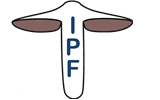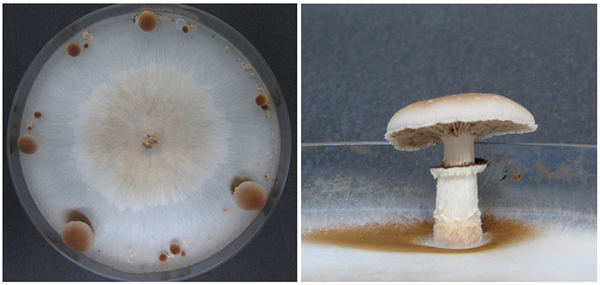Junior Research Group „Genetics and Genomics of Fungi“
Project
Agrocybe aegerita as a model basidiomycete to study the molecular genetics of fruiting body morphogenesis
Project description
Besides the major goal to understand the molecular mechanisms controlling the complex process of fruiting body formation in Agaricomycetes, yield and quality increase in edible mushroom production are another important goal of model basidiomycete-based research. For exhibiting certain upsides, molecular genetics-based studies on fruiting body formation are currently performed with a few well-established model agaricomycete species, i.e. Coprinopsis cinerea, Schizophyllum commune and Agaricus bisporus. Unfortunately, they all also display considerable individual downsides. C. cinerea and S. commune are for example not marketable as edible mushrooms in western industrialised countries and they exhibit untypical fruiting body development traits compared to other Agaricomycetes. A. bisporus, on the other hand, cannot be considered a ’text-book’ basidiomycete. The black poplar mushroom Agrocybe aegerita (also referred to as A. cylindracea), which has also been employed as a transformation-accessible model fungus previously, is a commercially grown high-quality agaricomycete mushroom with the outstanding capability of monokaryotic fruiting. In order to explore the molecular genetics controlling agaricomycete fruiting body development using A. aegerita as a model system, we have selected a set of A. aegerita standard wildtype strains. This includes a dikaryon, A. aegerita AAE-3, and a pair of mating-compatible monokaryotic strains derived from this dikaryon, the monokaryons A. aegerita AAE-3-13 and A. aegerita AAE-3-32, representing the extremes of the monokaryotic fruiting spectrum, which additionally brings along accessibility to a protoplast-based transformation procedure we developed. The selected strain set exhibits both ‘text-book’ basidiomycete and other highly beneficial features such as dikaryotic hyphae bearing clamps, a dikaryotic fruiting body formation which is completed after three weeks, monokaryotic oidiation and monokaryotic fruiting on standard agar media. Given the transformation accessibility of A. aegerita and the whole-genome of the selected A. aegerita standard wildtype strains sequenced and in silico annotated, A. aegerita appears to become a promising modern model system to study monokaryotic and normal dikaryotic mushroom formation applying molecular genetics approaches.
Short CVs
Dr. Florian Hennicke
01/2015-present Junior Research Group Leader, Senckenberg Gesellschaft für Naturforschung, Germany
03/2013-12/2014 Curator (IPF fungal culture collection), Goethe-University Frankfurt a.M., Germany
11/2008-01/2015 PhD Microbiology, Friedrich-Schiller-University Jena, Germany
2003-2008 Diploma Biology, Friedrich-Schiller-University Jena, Germany
List of selected publications:
Herzog R, Solovyeva I, Rühl M, Thines M, Hennicke F (2016) Dikaryotic fruiting body development in a single dikaryon of Agrocybe aegerita and the spectrum of monokaryotic fruiting types in its monokaryotic progeny. Mycological Progress 15: 947-957.
http://link.springer.com/article/10.1007/s11557-016-1221-9
Hennicke F, Cheikh-Ali Z, Liebisch T, Maciá-Vicente JG, Bode HB, Piepenbring M (2016). Distinguishing commercially grown Ganoderma lucidum from Ganoderma lingzhi from Europe and East Asia on the basis of morphology, molecular phylogeny, and triterpenic acid profiles. Phytochemistry 127: 29-37. http://dx.doi.org/10.1016/j.phytochem.2016.03.012
Knabe N, Jung EM, Freihorst D, Hennicke F, Horton S, Kothe E (2013). A central role for Ras1 in morphogenesis of the basidiomycete Schizophyllum commune. Eukaryotic Cell 12: 941-952. http://ec.asm.org/content/12/6/941.long
Hennicke F, Grumbt M, Lermann U, Ueberschaar N, Palige K, Böttcher B, Jacobsen ID, Staib C, Morschhäuser J, Monod M, Hube B, Hertweck C, Staib P (2013). Factors supporting cysteine tolerance and sulfite production in Candida albicans. Eukaryotic Cell 12: 604-613. http://ec.asm.org/content/12/4/604.long
Svobodová E, Staib P, Losse J, Hennicke F, Barz D, Józsi M (2012). Differential interaction of the two related fungal species Candida albicans and Candida dubliniensis with human neutrophils in vitro. The Journal of Immunology 189: 2502-2511. http://www.jimmunol.org/content/189/5/2502.long
Rennemeier C, Frambach T, Hennicke F, Dietl J, Staib P (2009). Microbial Quorum-Sensing molecules induce acrosome loss and cell death in human spermatozoa. Infection & Immunity 77: 4990-4997. http://iai.asm.org/content/77/11/4990.long
Robert Herzog
09/2013-present PhD student (IPF), Senckenberg Ges. für Naturforschung/Goethe-University Frankfurt a.M., Germany
01/2010-06/2013 Freelancer at Kneisz Design in Weimar, Germany
08/2011-03/2012 Work and travel stay in Australia
10/2002-12/2009 Diploma Biology, Friedrich-Schiller-University Jena
Publications:
Herzog R, Solovyeva I, Rühl M, Thines M, Hennicke F (2016) Dikaryotic fruiting body development in a single dikaryon of Agrocybe aegerita and the spectrum of monokaryotic fruiting types in its monokaryotic progeny. Mycological Progress 15: 947-957. http://link.springer.com/article/10.1007/s11557-016-1221-9/fulltext.html?view=classic
Dr. Irina M. Solovyeva
04/2015-present Postdoc (IPF), Senckenberg Ges. für Naturforschung/Goethe-University Frankfurt a.M., Germany
07/2013-03/2015 Research project manager, Goethe-University Frankfurt a.M., Germany
09/2010-06/2013 Postdoc, Biodiversity and Climate Research Centre (BiK-F), Frankfurt a.M., Germany
1999 PhD Molecular Biology, St. Petersburg Nuclear Physics Institute (Molecular and Radiation Biophysics Division), St. Petersburg, Russia.
List of selected publications:
Herzog R, Solovyeva I, Rühl M, Thines M, Hennicke F (2016) Dikaryotic fruiting body development in a single dikaryon of Agrocybe aegerita and the spectrum of monokaryotic fruiting types in its monokaryotic progeny. Mycological Progress 15: 947-957. http://link.springer.com/article/10.1007/s11557-016-1221-9/fulltext.html?view=classic
Solovyeva IM, Schmuker A, Cano L, van Damme M, Ploch S, Kamoun S, Thines, M (2015). Evolution of Hyaloperonospora effectors – ATR1 effector homologs from sister species of the downy mildew pathogen H. arabidopsidis are not recognized by RPP1WsB. Mycological Progress 14: 53.
http://link.springer.com/article/10.1007/s11557-015-1074-7/fulltext.html?view=classic
Solovieva IM, Kreneva RA, Errais LL, Perumov DA (2005). The riboflavin kinase encoding gene ribR of Bacillus subtilis is a part of a 10 kb operon, which is negatively regulated by the yrzC gene product. FEMS Microbiology Letters 243: 51-58. http://femsle.oxfordjournals.org/content/243/1/51
Solovieva, IM, Entian, KD (2004). Metalloregulation in Bacillus subtilis: the copZ chromosomal gene is involved in cadmium resistance. FEMS Microbiology Letters 236: 115-122. http://femsle.oxfordjournals.org/content/236/1/115
Solovieva IM, Kreneva RA, Leak DJ, Perumov, DA (1999). The ribR gene encodes a monofunctional riboflavin kinase which is involved in regulation of the Bacillus subtilis riboflavin operon. Microbiology 145: 67-73. http://mic.microbiologyresearch.org/content/journal/micro/10.1099/13500872-145-1-67#tab2

